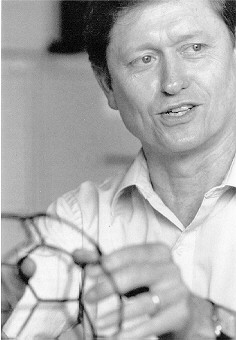
COMBUSTION and FUELS
MIT Energy Laboratory
 |
Current Research:
COMBUSTION and FUELS MIT Energy Laboratory |
Combustion chemistry research at MIT focuses on fundamental problems affecting applications including energy conversion and utilization, environmental quality, synthesis of new carbon materials such as fullerenes, and destruction of hazardous substances. The research includes detection and measurement of short-lived free radical intermediates important to how fast and how completely combustion occurs, kinetics experiments and prediction of rate coefficients and thermodynamic properties, and mathematical modeling of combustion reaction networks such as the growth and destruction of polycyclic aromatic hydrocarbons and soot particles. Health effects of combustion emissions are being studied in collaboration with analytical chemists and toxicologists.
Combustion engineering researchers are now developing design strategies for modified or novel combustion processes that will permit fuels with higher contents of nitrogen and aromatic hydrocarbons to be burned more efficiently and with less pollution. Their approach involves both experimental studies and computer modeling.
Other research has emphasized fundamental and more applied studies of high-temperature reactions, for example, pyrolysis, combustion, and gasification of various fuels including coals, biomass, natural gas, liquid petroleum products, and their derivatives. Topics of interest include mechanisms and kinetics of gas-solid reactions, gasification of carbonaceous solids, deposition of solids from gas-phase products of combustion or gasification, reactions of fuel-bound and exogenous mineral matter, and reactions for control of sulfur oxides (SOx) and nitrogen oxides (NOx). Other projects are extending our understanding of high-temperature gas-phase reactions. Of special interest are the fuel-rich oxidation of hydrocarbons and the role of mixing in chemical reactions in gasification and combustion systems.
Past work in a pilot-scale combustion research furnace led to a number of innovations, including the development of a novel low-NOx gas burner that has been commercialized by ABB Combustion Engineering Company. When MIT installed its new cogeneration plant to provide the campus with electricity and steam, this low-NOX-burner technology was incorporated into the turbine combustor and was a significant feature in MIT's receipt of necessary environmental permits for installation of such a unit in an urban area.
Studies of fluidized bed combustion have provided detailed information for improved fluidized bed combustors (FBCs) that can burn coal more efficiently and cleanly. Studies in a pilot-scale fluidized bed combustor (0.6 m by 0.6 m in cross section, 4.5 m high, with a rated heat input of about 750 kW) have provided information on the spatial distributions of temperatures and of concentrations of gaseous and solid species both within the fluidized bed and in the combustion space above the bed. The experiments have also shown how operating variables affect emissions of pollutants such as NOx, SOx, and polycyclic aromatic compounds. Other tests take place in a 1.2 m by 1.2 m model of a bubbling FBC and in a 20 cm model of a circulating FBC, both of which operate at room temperature. Tests have verified that these cold beds, designed using dimensional analysis, can accurately model the hydrodynamic behavior of much larger combustors. Experimental data from these devices are used to develop mathematical models of important fluidization, combustion, and heat-transfer processes. Recent results have shown that small models can closely simulate the dynamics of pressurized bubbling and circulating combustors and gasifiers. Small-scale studies are also providing the mechanisms and kinetics for nitrogen oxide, nitrous oxide, and carbon monoxide formation and destruction for use in the systems models. Research is starting on the simulation of a second-generation combined-cycle combustor, designed to convert coal to heat and electricity at even higher efficiencies.
In our fuel conversion research program, we focus on transforming fossil and biomass fuels into higher-quality products better suited to clean burning in conventional combustors or in advanced, high-efficiency direct conversion devices such as fuel cells. Conversion research also examines transformations that facilitate the storage and transport of fuels.
Much of our fundamental research in the last decade has focused on understanding high-temperature chemical reactions important for converting fuels or removing pollutants. Other fundamental work investigates industrially important reactions that involve catalysis or that occur in a thermal plasma, an energetic gaseous electrical discharge that generates high temperatures and reactive chemical intermediates. These techniques allow reactions to occur at much higher rates and can permit increased yields while limiting the production of undesirable by-products.
 |
Professor Jack B. Howard of the Department of Chemical Engineering discusses recent experiments in which he and his colleagues synthesized buckyballs (fullerenes) in hydrocarbon flames. Recent spectroscopic data indicate that their samples may contain new fullerenes unique to flame synthesis, among them some having 60 carbon atoms that occur in a configuration differing from that in the traditional soccer-ball-shaped buckminsterfullerene, shown here in the molecular model. |
 the
Energy Laboratory Home Page.
the
Energy Laboratory Home Page.